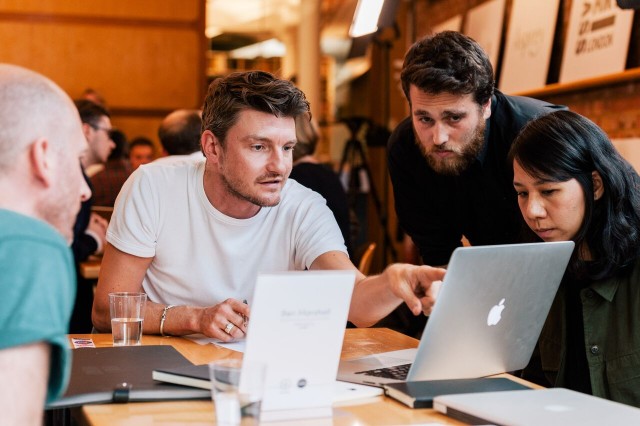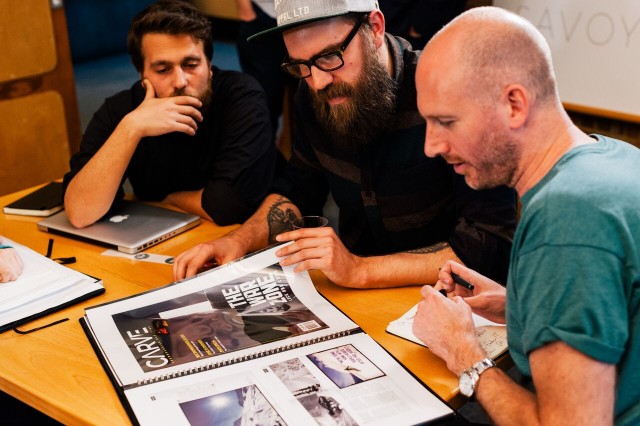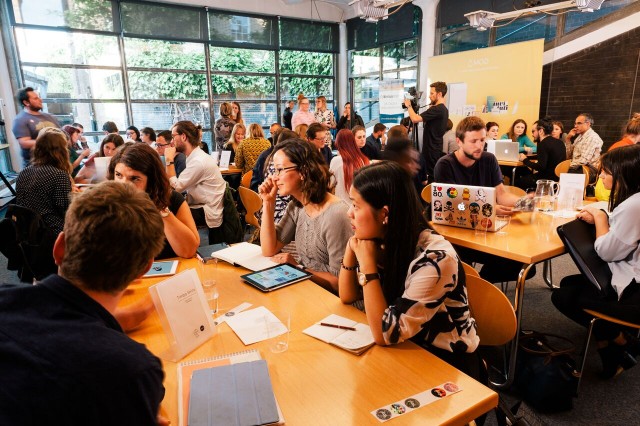
Top Portfolio & Interview Tips From Creative Directors & Pentagram Partners
The Dots held a Graphic Design Portfolio Masterclass at the incredible design consultancy, Pentagram.
This was to give emerging Graphic Designers the chance to have their portfolios reviewed by Pentagram Partners and some of the UK’s best Creative Directors, Heads of Design and Art Directors.
Whilst the industry leaders were in the room, The Dots team asked them for their top tips to get ahead as a Graphic Designer. View all the recorded video tips here.
2 Top Tips For Putting Together An Outstanding Portfolio

1. Show off all of your skills.
A mutual opinion between the industry leaders was the idea that you should show all of your capabilities in your portfolio – but make sure it’s engaging.
Leif Podhajsky (renowned Graphic Designer/Art Director) said “I would like to see a set of designs where you can show me a good layout, where you can pick a typeface, that you’ve got basic coding skills, that you can take a photo, that you can do something from concept all the way through to completion […] if you can show me an interesting way of how to do those then you’ve got a good portfolio”.
2. Keep it short and sweet!
This is all well and good, but you don’t want to overburden the interviewer with tons of projects and briefs you have completed.
Jane Scherbaum’s (Deputy Head of Design at the V&A Museum) advice was to, “edit, edit, edit. Distil everything down to the really really strong projects that communicate what you as a Designer are about. Include work that you can really talk about, what’s the central idea to each project, distil it down to that. Think about who the portfolio is going to be shown to, tailor it and that all comes back to ‘edit, edit, edit’”.
Paul Pensom (Art Director, Creative Review) supported this, adding that you should, “always remember that your portfolio is a calling card, not a filing cabinet, so don’t throw everything into it. You’ll be remembered for one or two pieces so choose carefully and edit ruthlessly.”
In the words of Paul and Jane – edit!
[youtube http://www.youtube.com/watch?v=kyo-cjhUSOE&w=560&h=315]
4 Top Interview Tips

1. Be confident, be friendly & be inquisitive.
If you’re anxious before an interview, remember that the person questioning you has been in a similar position so will completely understand what you’re going through!
Timba Smits’ (Creative Director at TCOLondon) most important interview tip is to “come into that room and just try to be as natural as possible. I know it’s hard to say but at the same time, I’m just a person… I’ve been in the exact seat that you’ve been in so just walk in there with a bit of confidence and a bit of flair behind your portfolio”.
Paul Pensom agreed, adding that his top interview tips are to “be confident, be friendly and be inquisitive”.
2. Prepare & Research
It’s incredibly important before an interview that you research the agency that you’re applying for and (if you know who is interviewing you) the interviewer.
Whilst in the interview, be sure that you know what the organisation stands for and why you think you would fit in. Harry Pearce (Partner at Pentagram) told us, “my tips for an interview are to be calm, be clear, know about the person that you’re meeting. Understand their work”.
Be sure to prepare yourself for criticism as well. As Corrie Anderson (Head Lecturer at Shillington College) stated, “be prepared to take on criticism as people will ask questions and potentially be critical”.
Being criticized is a useful part of growth, so take it with a pinch of salt. If you respond well to criticism you’ll be in the potential employers good books. Just see it as preparation for when you show your work to clients – they’re not going to like all the work you do!

3. Explain method behind the idea
Naresh Ramchandani (Partner at Pentagram) supported this idea, and said you should “really take the trouble to explain your work as you are showing it, rather than assume the work explains itself. I think the narrative, the heart and the intention that you’ve got behind the campaign or the piece of work is as much what you’re buying when you hire someone as the piece of work itself. The personality has got to come out, as well as how accomplished you are”.
Companies are searching for people who have brilliant ideas, so describing the story and method behind your work is a good way to show how your mind works.
4. Be Concise.
That being said, prolonged explanations aren’t for everyone, so make sure to be concise.
Timba Smits said to, “let your work do the talking and just try to be the rose amongst the thorns” – don’t overburden the interviewer. If they are interested, they will be sure to ask.
Harry Pearce also said to, “let the person who’s interviewing discover your work rather than over explain it or kind of over embellish the story. I think so many people come to an interview with me and tell me how much fun they had doing something – I’m really not interested in that. I’m interested in the quality of what you’ve brought to show”
The main point here, is that all interviewers are different, so if possible – try to establish if the interviewer will be the sort of person that like to hear the story behind a project, or would rather look at the work and ask questions.
Looking to get feedback on your portfolio? The Dots host monthly Portfolio Masterclasses, focusing on a variety of professions. Register your interest in upcoming Portfolio Masterclasses here. Photos by Jack Woodhouse.
More Tips & Resources for Students
- Design Agency Job Hunting Tips
- 7 Ways Designers Can Get Their Foot In The Door
- Top Design Schools & Tips For Choosing One
- Top 10 E-mail Etiquette Tips During Your Career Search
- Elements of a successful online design portfolio
- The Pros’s and Cons of Spec Work
- Tips for Building & Optimising Your Online Portfolio and Digital Network
- 6 Simple But Important Tips for Design Students
- Advice For Design Students
- Top 10 Design Questions from Students
- How and where to get paid freelance work while you are still a design student
